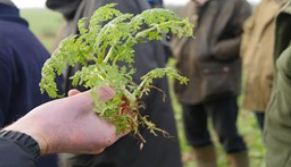What are cover crops, catch crops and green manures?
Cover crops, catch crops and green manures are non-cash crops that provide potential benefits to a rotation.
Typically, cover crops are grown over a single winter to cover bare soil and stubble. However, the duration of the cover can vary from a few weeks to several months or years, depending on the approach and the specific objective.
Although the terms cover crop, catch crop and green manure are used interchangeably, they can distinguish between different functions:
- Cover crops ‘cover’ the soil between the harvest and establishment of main (cash) crops
- Catch crops ‘catch’ available soil nitrogen and prevent nutrient losses (via run-off and leaching)
- Green manures improve nutrition for following crops through the capture and release of nutrients, and the addition of fresh biomass (organic matter)
Crops can deliver multiple functions.
For example, a relatively fast-growing winter green manure in an over-winter fallow field (before spring crops) can provide all three functions. However, a summer green manure grown in short (two- to six-month) blocks between crops provides a quick boost of nitrogen only.
Leys, made up of mixtures (including grass, clovers or herbs), can provide cover for relatively long periods (typically 12 to 18 months). These are often used in organic systems before nutrient-intensive crops, such as brassicas.
Why grow cover crops?
Incorporating cover crops into a rotation has many environmental and soil benefits. Carefully selected crops can help manage soil erosion, soil fertility, soil health, water, weeds, pests, diseases and biodiversity. The right choice depends on your objectives.
Learn about the reasons for growing cover crops
Types of cover crops
There are many types of cover crops. Each cover crop or species mix has different properties, so it is essential to select a suitable option. Your choice needs to fit in with farm practice, capabilities, expertise and equipment. It also needs to work with the system, including the rotation and soils. Critically, it must address your objectives.
Find out about the types of cover crops
How to establish and destroy cover crops
Good crop establishment and growth are essential to maximising benefits. As well as direct management of the cover crop, destruction and following-crop establishment should be considered.
How to evaluate cover crops – a five-step process
With diverse options of cover crops and systems, finding an approach that fits your farming situation is important. When considering a cover crop, follow these five steps.
A five-step approach to evaluate cover crops
Further information
Read our cover crop research review
Find out about our cover crop research project which completed in 2020



